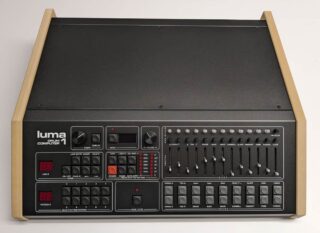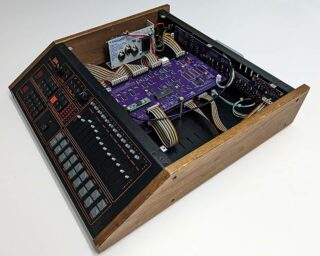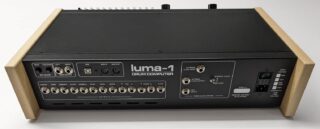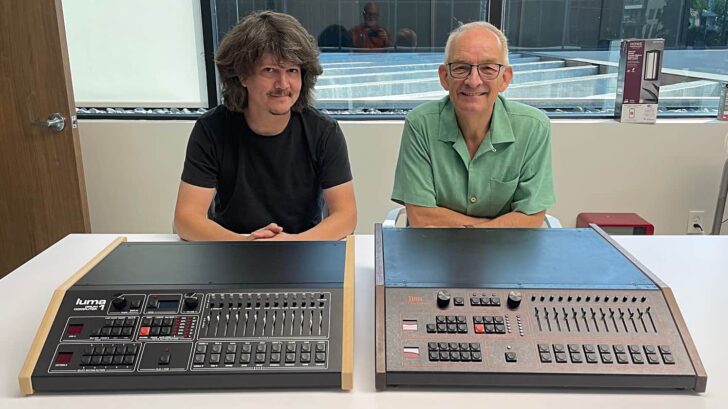Roger Linn’s classic Linn LM-1 Drum Machine is getting reborn, full-size and faithfully recreated, as the Luma 1 Drum Computer.
The Luma-1 is an authentic recreation of the original Linn LM-1, designed by Roger Linn in 1979 and now brought back by engineer Joe Britt. Fully recreating the original design of the LM-1, it utilizes the same audio path (with the original vintage DACs and filters), runs the original LM-1 software, and adds a secondary modern processor to support modern features like loadable sounds, USB connectivity and MIDI.
Here’s Britt with the Luma 1 and Linn with the LM-1:
The Luma 1 started as Britt’s hobby project, adding some features to the LM-1 design. At that point, it was being described as an LM1+. Here’s a demo of the prototype:
Britt demonstrated the Luma-1 to Linn, who wrote about it on his site, which attracted interest from the LM-1 community.
In his design, Britt remained faithful to the original hardware circuit, but:
- He replaced the original sound ROMs with RAM chip;
- He added a Teensy CPU board and software to support loading sounds into RAM and other new features; and
- He replaced the original front panel 3-position pan switches with full-rotation pots–with illuminated shafts– that could act as either full pans or pitch controls.
Because of interest, plans are being made for a limited production run of the Luma-1. Engineers Andrei Kudryavtsev and Devin Riley will lead the Luma-1 project to make it available to the Pro and DIY enthusiast communities. A small batch of pre-assembled units will be available for pre-order in September 2023. The production of Luma-1 will be entirely US-based, including the enclosure, PCB, and component assembly. To address the needs of the DIY community, kits will be announced later this year.
Here’s what Britt has to say about the impetus for the project:
“As a kid growing up in the 80s, the sound of the LM-1 was the sound of my people. The Human League, Heaven 17, Yazoo, Gary Numan– so many of my favorite bands from that time built their sound around the LM-1.
And of course Prince, who used the LM-1 to create the ‘Minneapolis Sound.’ So I started with a very emotional attachment to work created with the LM-1.
I love technology, and I love products, and I really love taking things apart to understand how they work. Once I understood how influential the LM-1 was, I wanted to understand what was inside. But there were so few LM-1s made, and I could find relatively little detailed information about them online.
I finally found those nth-generation schematics, and could at least understand the hardware architecture. (But it wasn’t clear enough to build a clone.) The schematics did reveal some very surprising design details. The first was that there was a DAC per voice! I did not expect that. And then — the sample rate clocks were from 555 timers, holy smokes! Then I realized that the Z-80 wasn’t using interrupts (whoa!), and that there was something special about how the Hi Hat sounds are made.
The LM-1 was just this box of technical surprises, and all together they created something that was just magical. The samples are digital, but the playback clocks and the tempo clock are generated by non-digital sources (the 555 timers, and an analog VCO for the tempo clock). So it’s mostly digital, but with a very non-digital ‘heart.’
Couple all of that with your very clever Shuffle algorithm, and some happy accidents like the bit of delay at the front of the Snare sample, and out comes the magic. Reverse-engineering magic is very rewarding.”
How Close Is The Luma-1 To The Original LM-1?
The entire audio signal path is identical to the LM-1.
The Luma-1 uses a Z-80 just like the original LM-1, and runs the Rev 3 LM-1 firmware.
It has the same loose sample rate and tempo clock generation, 9x (one per voice) 8-bit µ-law DACs, OpAmps, and AS3320 (or CEM3320) filters on the Conga/Tom and Bass voices. Unlike the original, the filter cutoff controls are externally accessible.
On the digital side, the samples are not stored in EPROMs, but rather individual per-voice RAM chips. Drum samples are loaded into those RAM chips either from an internal SD Card or by downloading via SysEx. That allows for hot-swappable sample storage, whether it’s the original bit patterns of the LM-1 voice EPROMs, other sample-based drum machines (such as the DMX or DrumTraks), or totally new sounds. Samples can be 2KB, 4KB, 8KB, or 32KB in size, allowing a wide variety of vintage and new sounds to be loaded. (Note: due to the way the Conga/Tom voices work, those samples can be 2KB, 4KB, 8KB, or 16KB.)
To facilitate these features and more, a new ARM CPU works in tandem with the original Z80, which has the bonus effect of allowing easy implementation of MIDI and USB.
Two compromises were made:
- The original cassette tape memory system has been omitted, since all patterns can be saved to and loaded from SD Card.
- The original “Tape Sync” that let the LM-1 chase a sync tone laid down on audio tape has been replaced with synchronization via MIDI Start/Stop/Clock.
Here’s a preview of a recent prototype in action:
https://www.instagram.com/p/CwTntLVLMUB/
Pricing and Availability:
The Luma-1 will be priced at $4,999, the original price of the Linn LM-1. Orders will be manufactured in the order they arrive and delivered starting later this year. Details on kits are still to be announced. See the Luma-1 Overview for details (Google Doc file).





5K? Uli, please.
:grimace: :joy: :tears:
People dont appreciate a good handcraft design and don’t want quality. Thank you for proving that.
This is a music nerd’s passion project to fulfill a childhood dream. Reason and affordability has nothing to with it. What do you want with a cheaper version that is not an exact replication? Can’t you just use a modern sampler like Digitakt then?
$4,999? Commoners can move along.
its cheap for people with jobs
Cheap? LOL. In this day and age, for what it does, it is not cheap.
The thief you mean?
If there’s no alternative it’s amazing to have such a hardware again
But to be honest there are great alternatives as I do have original Linn wave samples I could load them into my Mayer MD and have the sound
Or i any other sampler with amazing features
Like the Iridium
Also for not so big wallets there the https://www.alyjameslab.com/alyjameslabvlinn.html
amazing plug-in that is 99.99 % sounding linn drum
And is indeed very cheap so check that as well
For the others save until it’s to late and you can’t get this hardware any more like the linn drum form the 80s
They might consider selling the metalwork, pcb’s, front panel buttons as a DIY similar to the RE-909. This one would be a very fun build.
It says above that this is going to happen. <3
"A small batch of pre-assembled units will be available for pre-order in September 2023. The production of Luma-1 will be entirely US-based, including the enclosure, PCB, and component assembly. To address the needs of the DIY community, kits will be announced later this year."
I’m with Michael. Its hard for me to get gear-wood over this one when the sounds are so easily had for many platforms. I have dozens of drum kits at a click. $5K for a 3rd Wave seems more sensible, but hey, I’m not the boss of you.
Software synths got so beefy, I gradually ditched a lot of hardware. I couldn’t have a CS-80 any other way. I’m not against the Luma-1 at all; its a brilliant accomplishment. The software world won me over a while back, is all.
For all you guys saying “I can just get the sounds, and load them into *** (insert name of crap sampler)”, you need to understand that the sounds are only part of the experience. What you pay for, is the craftmanship, attention to detail, and the interface. Interface is everything. And of course the legacy, there’s no denying that.